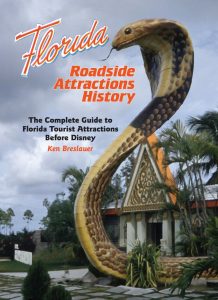For a better future, study the past.
Menu
For a better future, study the past.
Breslauer, Ken. Florida Roadside Attractions History: The Complete Guide to Florida Tourist Attractions Before Disney. N.P., 2018. ISBN 9781532363337. Hardcover, 208 pages, color and b/w photos. $32.

For those who long for the days of getting in the car and driving, only stopping at at a Stuckey’s for a pecan log roll and a Coke and at every roadside attraction along the way, I have the book for you. Ken Breslauer has compiled a large collection of these often times cheesy and yet classic locations that were located in the state of Florida. In an easy to use A-Z format armchair travelers will be taken back to the days before Disney, Sea World, and Universal ruled the tourist market of Florida.
In his introductory chapters the author outlines Florida tourism in the years before the invasion of Walt Disney World. Early Florida attractions tended to focus on natural resources. Gardens, animals, and water were the standard draw. By the 1870s glass bottom boats were already attracting visitors to Silver Springs. Attractions held several things in common no matter the location or subject. Colorful billboards, mass distributed brochures, and a well stocked gift shop selling souvenirs and postcards to entice the folks back home were a standard.
Florida was somewhat an isolated area until water and rail transport opened the state to wider visitation. The belief in the medicinal benefits of sunshine and warm weather drew northerners by the thousands in the late 1800s. Wealthy northerners help line the pockets of men like Henry Flagler who built grand hotels up and down the east coast of the state. His Florida East Coast Railway would deliver tourists practically to the hotel doorstep.
By the 1920s travel by car was exploding and “tin can tourists” took over from the rail lines. The Florida Land Boom/Bust helped push the state into depression several years ahead of the country and the state was able to recover in a quicker fashion due to tourism and the coming of World War II. While the war was a disaster for roadside attractions as people were not travelling and millions were drawn into the service, the ending of the war was a boom time and returning soldiers and their families visited and often moved to the state.
So great was the recovery that in 1949 the Florida Attractions Association was born in an attempt to develop standards and weed out attractions that did not live up to their advertised promises to visitors.
At this time attractions were built close to the major roadways in the state; US1, US41, and US27. Changes were coming to Florida tourism however as interstate construction drew road travelers away from the prior routes and previously successful attractions. A second trend was corporate ownership. No longer were family owned attractions the norm. Many of the smaller attractions could not keep up financially and their offerings became less interesting. This is certainly coupled with the third change which is the increase in expectations of visitors. Tourists were becoming harder to please and expected more. They wanted to be entertained and not just see nature. A fourth change is the increase in land values and developmental pressures. For many owners the chance to sell their land at large profits was too great to pass up and many attractions fell to the wrecking ball only to be replaced by strip shopping centers and fast food restaurants. A fifth change is the increase in air traffic. As flying became a more accepted travel expense tourists would fly directly, or very close to, their destination. The era of the road trip was declining. A final change was the arrival of Walt Disney and his mammoth Walt Disney World. The Magic Kingdom became the destination and was not just a stop in a larger vacation. Kids were more interested in seeing the animatronic Country Bears rather than an alligator farm and parents were happy to oblige.
While there are some of these incredible attractions sill in operation the vast majority are only memories; available to us today in photos, postcards, and surviving souvenirs. In this book Mr. Breslauer introduces us to more than one hundred of these beloved locations. Each location receives one to four pages including a brief text and several amazing images. Some, such as Bok Tower, Gatorland, and Six Gun Territory may be familiar, the majority such as Musa Isle, Seville Peacock Farm, and Pirate’s World are unknown to most of us.
Breslauer appears to be missing an opportunity by not selling his book on Amazon. Rather, visit his web page for further information or purchase the book by going to ebay where you can order a signed copy. Highly recommended for travel enthusiasts, Florida historians, or those looking to relive a simpler time before the days of $100 admission prices and $15 cheeseburgers.
Affiliate links are used in this post. I may receive a small referral fee that does not impact any purchase you make. Reviews are honest opinions.